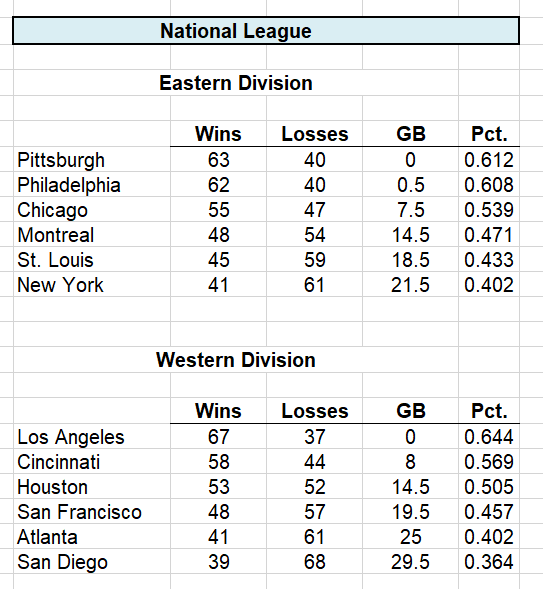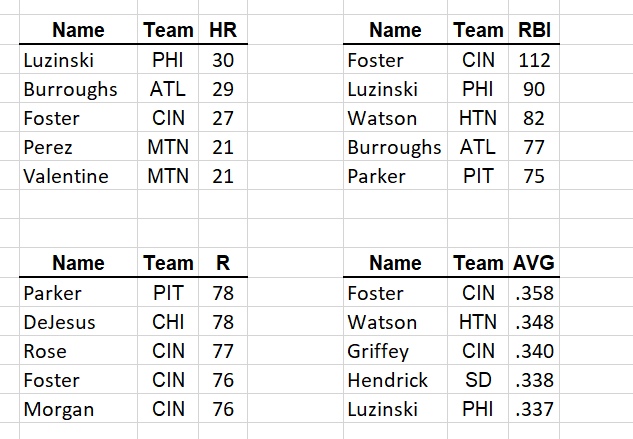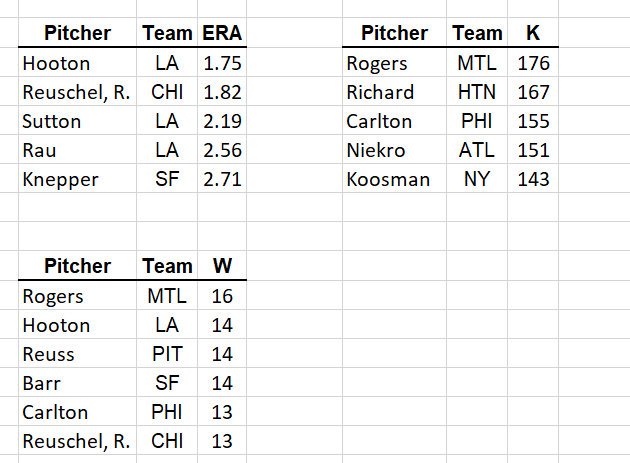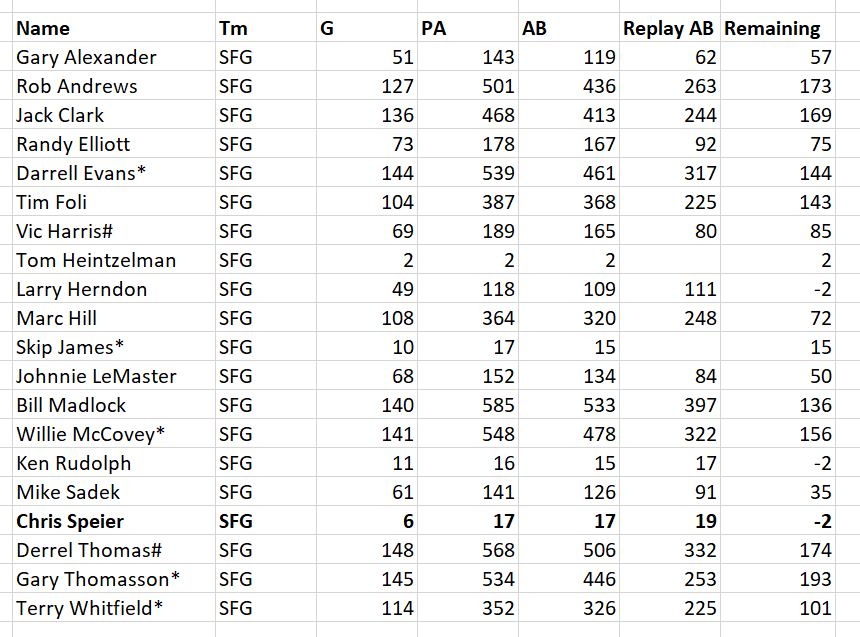I heard from friend and APBA fan Jim Saska. He sent me a midseason recap of his 1977 replay. Playing both the AL and the NL, Jim is already over 100 games into the replay. Those who have taken on these projects understand how formidable this is.
Jim’s quick recap:
In the NL, LA went 23-5 to take a commanding lead in the NL West, while Pittsburgh went 21-9 to take over first place from the Phillies. The Cubs had a bit of a rough month in July, going 14-17, but still in the race in the East.
Jim sent me his Excel files so I could take a gander at the stats and stats. I had a lot of fun delving into his setup.
A look at the National League…
Yeah, go Cubs! A winning record! Jim’s replay standings are pretty close to the real-life mark.
The Cincinnati Reds really dominate with the bat. Foster, Griffey Sr., and Morgan are producing as expected. The Phillies’ Greg Luzinski is the leader in homers with 30. Not bad for just 102 games.
I’m guessing that part of the Cubs’ success in due to Rick Reuschel. He’s second in ERA with a 1.82 to Burt Hooton’s 1.75 mark. That’s helped him to 13 wins which is fifth in the NL. Montreal’s Steve Rogers paces the league with 16 victories and 176 strikeouts.
I often get a glimpse into how APBA fans plan and conduct their APBA replays. From Rod Caborn and Don George and my commissioner Mike Bunch, it’s helpful to get tips and tricks on better plan out a replay. Jim’s replay is no exception.
Looking through Jim’s spreadsheets, I found an interesting feature. I see that he diligently tracks “AB Limits” and “AB Remaining”. That tells me that he is attempting to keep the players within their actual playing time.
Jim has even put in formulas so that “AB Remaining” value will be automatically calculated. Here is an example…
I know that some APBA fans are not as particular about player usage limits. That’s the beauty of the APBA game. It’s our game and we play it in the way that brings us the most joy. This does show that there is a demand for cards for player for few (at-bats or innings). It helps with coverage.
Thanks for the update, Jim. I’ll explore the AL another time.
Kudos on your progress on the 1977 replay!








Yes, that multi-league replay is quite an undertaking.
Geek question from another replay guy – And feel free to ignore as it’s quite granular!
I’ve noticed that my single team replays track actual stats pretty darn well.
But errors (E) are consistently overstated and caught stealing (CS) and wild pitches (WP) are usually understated. I’ve made some tactical calibrations to deal with these aberrations, but was wondering how Mr. Saska’s replay E, CS and WP compare to actual 1977 stats. Baseball Reference provides CS as .42/game, WP as .28/game and E as .88/game for both leagues in 1977.
Don, unfortunately, I don’t keep track of E, CS and WP, although I have tallied the number of errors by team on each scoresheet of the replay so at some point I’ll go back and tally the errors by team. I also use some modification to my BG replay where I use the error and unusual play randomizer charts, as well as a stolen base modification where SBs aren’t automatic, but based on the MG steal rating, catcher’s throwing arm and pitchers move to first.
Yes, those multi-league replays are quite an undertaking.
Have a geeky question, so feel free to ignore if too granular!
In my single team replays, I’ve noticed that Errors (E) are consistently overstated, and Caught Stealing (CS) and Wild Pitches (WP) are understated.
I’ve made some tactical calibrations to account for the aberrations, but was wondering how these stats are playing out in Mr. Saska’s replay. Baseball Reference provides .88 E/game, .42 CS/game and .28 WP/game for 1977, both leagues combined.
i was curious if Mr. Saska is using cards and dice, and if it’s basic. i’m pulling for the Reds but they just don’t have the pitching to catch the Dirty Dodgers. that’s right, the Dirty Dodgers. oooh, i sure miss that rivalry of my youth. too bad it’s not there anymore, with realignment. i recently acquired the original ’77 set and can’t wait to get into it, except for league play and a couple side projects i got going already. enjoy the rest of it.
Erik,
Using cards and dice, modified BG replay using Coxx chart, Error and Unusual Play randomizer charts, also modified strikeout and control ratings, and roll dice for stolen base attempts based on MG ratings for runner, catcher and pitcher.
Don, unfortunately, I don’t keep track of E, CS and WP, although I have tallied the number of errors by team on each scoresheet of the replay so at some point I’ll go back and tally the errors by team. I also use some modification to my BG replay where I use the error and unusual play randomizer charts, as well as a stolen base modification where SBs aren’t automatic, but based on the MG steal rating, catcher’s throwing arm and pitchers move to first.
Erik,
Using cards and dice, modified BG replay using Coxx chart, Error and Unusual Play randomizer charts, also modified strikeout and control ratings, and roll dice for stolen base attempts based on MG ratings for runner, catcher and pitcher.
Yes, that is a lot of work as Jim has played over 1300 games so far. I’m 27 games into a fantasy season based on the early 1970s league structure using the BATS 3 sets.
As for Don’s question, I adjust errors on the base empty fielding one column results 18-20 with a die roll. 3B5, SS9 and 2B8 make the play on a roll of 1-3. 3B6, SS10 and 2B9 make the play on a roll of 1-4.
Just wondering, I ‘d like to ask Jim if there has been any no-hitters.
No Don, amazingly not. I’ve had two or three pitchers (Tom Seaver most recently) come close with two outs in the ninth. Still rooting for my first one!